Multiple reports of fire in a single-family residence interrupted the morning routine for firefighters of the Seattle (WA) Fire Department on a sunny Saturday in February. Responding units were informed by dispatch, “The mom is reported to be inside, possibly upstairs. Unknown whereabouts.” The full response sent to the incident was as follows: Engines 18, 21, 35, 20, and 9; Ladders 8, 5, and 4; Battalions 4 and 2; Deputy 1; Safety 2; Staff 10; Medics 18 and 44; Aid 86; Air 240; Rehab 1; and Marshal 5.
- Civilian Rescue: The Reason We Exist
- High-Target Areas for the Residential Primary Search
- The Dangers of Hoarder Fires
- Hoarding: A Fire Prevention and Response Concern
Engine 18 on Scene
On arrival, Engine 18 (E18) encountered heavy, gray smoke in the area that limited the structure’s visibility and the fire location. E18’s officer gave the following report: “Engine 18 is at 1107 NW 65 Street. We’ve got a working fire. Engine 18 will be 65 Street Command. On a hydrant.”
The structure was a wood-frame, 1½-story, single-family residence, roughly 2,000 square feet with a basement. There was a doorway in the front (A side) leading through a small foyer/mudroom to the living room; there was a door on the B side that led to the kitchen; and on the C side, stairs led down to a doorway and the basement.
As the crew exited the rig, they were met by occupants of the involved house who confirmed the report of a trapped victim. They identified the person as their mom and that she was in the upstairs part of the home. They pointed to the A-side window on floor 2, facing the street, and indicated that was her bedroom. The E18 officer determined the report to be credible.
While a preconnect was being laid to the house, the E18 officer conducted a 360° size-up and the other team member looked for the best entry into the home. Heavy smoke and fire were observed on the B/C corner, and it was thought to be a kitchen fire. The lack of fire from the A-side door and a clear view through a basement window in the back, with nothing showing, indicated this was a first-floor fire.
E18’s officer relayed the following transmission: “360 complete, we have a basement. Looks like the involvement is all on floor 1.” E18 began the fire attack through the B-side door.
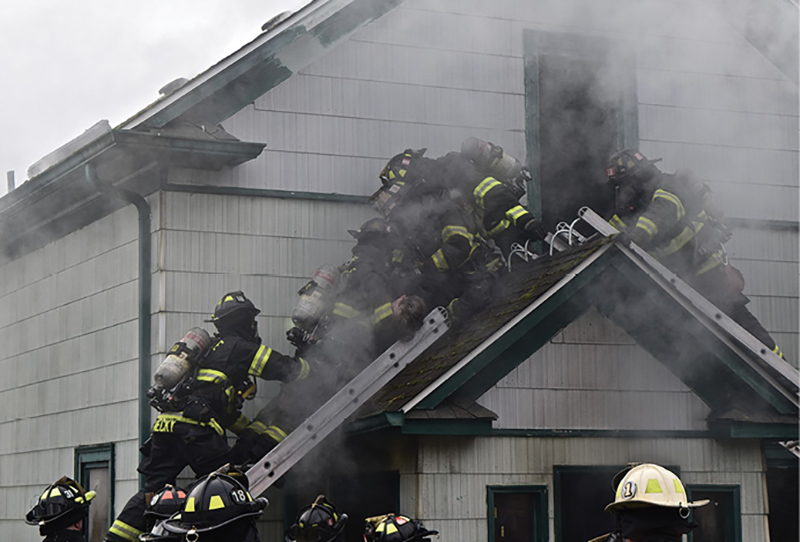
(1) Photos 1-2 by John Odegard.
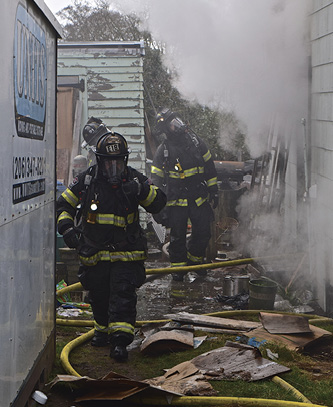
(2) Heavy fire from the B door initially. Fire attack began on what was thought to be a first-floor kitchen fire.
Ladder 8 on Scene
Prior to arrival, the Ladder 8 (L8) officer noted the credible report of a victim on the second floor and discussed a search plan. He indicated they would split the crew, directing Team B to conduct vent-enter-search (VES) operations on floor 2 while Team A would enter on floor 1 and attempt to access the victim using the interior stairs. On arrival, that plan was put into action and L8’s officer gave the following report: “Ladder 8 is at. First truck. Splitting.”
Ladder 8A received credible information from occupants that stairwell access to floor 2 was best achieved through the A-side front door. The stairs were reported to be on the right-hand wall of the front room, after entry through the front door and small foyer/mud room. Both the interior search and the VES were targeted at the floor 2 bedroom, where the highest likelihood of a victim was present.
The interior search immediately became more difficult than planned as Team A was confronted with hoarder conditions. After an initial attempt to get through the furniture and other piles of room contents, they were unsuccessful in locating the stairs. They quickly exited and got additional directions from the occupants that placed the stairwell toward the back of the living room, and Ladder 8A found the stairs on reentry.
Engine 18 Confirms Basement Fire
The fire attack, at the B door, was conducted by a team from E18 and E21. Despite aggressively flowing water into the door, they could only darken the fire down but not create a path for entry. E18’s officer checked back in with the attack team and evaluated the basement windows again. There was now smoke and fire visible through the window and growing rapidly.
The presence of a confirmed basement fire was transmitted, as E18’s officer relayed the following message: “Command from Engine 18, we’ve got heavy fire involvement in the basement. We need a line around the Charlie side.” Command confirmed this request, and E35 was assigned to bring an attack line to the C side. Supply and a redundant supply were provided by E21 and E35, who arrived on scene at the same time.
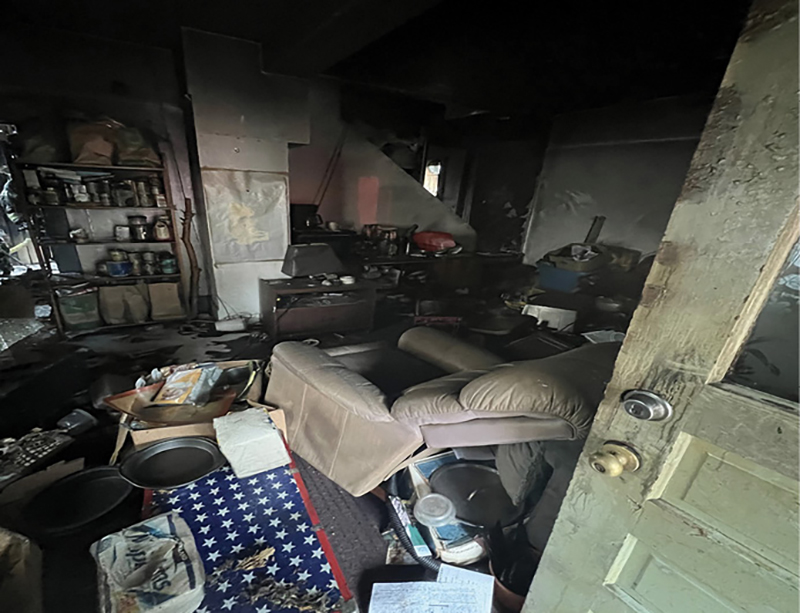
(3) A view through the front door. Hoarding conditions slowed search in zero visibility. (Photos 3-8 by Tim Frank.)
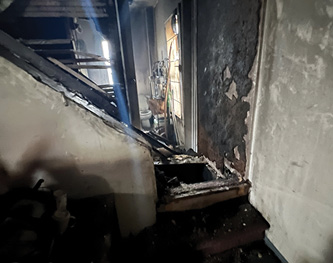
(4) Fire was pushing up through the treads and at the landing. A confirmed basement fire, with no handline protection, forced search crews out to assist with VES on floor 2.
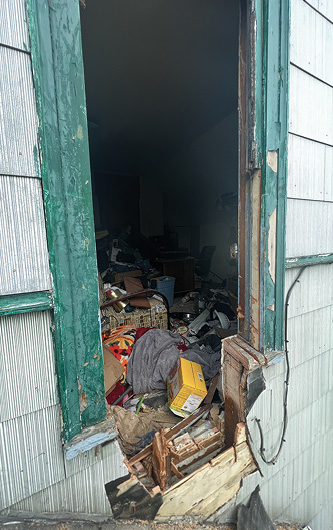
(5) Hoarder conditions. Searchers entered into zero visibility and heavy debris.
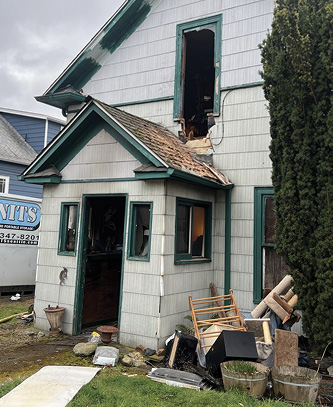
(6) A pile of material was removed from the bedroom to help clear a path for rescue.
Ladder 8 at the Stairs
Once at the stairs, which were stacked leading from the basement to floor 2, the crew encountered fire pushing between the treads at the landing. An initial plan of knocking down the fire with a pump can was altered when E18 radioed the presence of heavy fire in the basement. L8’s officer determined the stairs were (or would soon be) compromised and chose to assist Team B with VES. He radioed the following: “Our progress to get to floor 2 interiorly was cut off by fire; we are going to VES the window that the occupant was told to be in. Front window, Alpha side, floor 2.”
Ladder 5 Vertical Vent to VES
On arrival, the initial plan was for L5 to evaluate for vertical ventilation. The incident commander (IC), now recognizing the presence of a basement fire, changed the assignment to bring positive pressure ventilation fans for possible use and initiate a second VES operation (L5 Team B) on the C side, floor 2 window. In addition, L5A would begin a search on floor 1. Both sides of floor 2 would now have rescue operations going on simultaneously with a team of four in the A-side bedroom (which was reported to have the trapped victim) and a team of two in the only other floor 2 room (on the C side). L5’s officer radioed the following: “Command from Ladder 5, we have a second bedroom on the Bravo/Charlie corner. Team Bravo is going to VES while Alpha is entering for a primary search.”
E21/E35 Lines to the Basement
E21 radioed that the stairs on the C side, leading directly to the basement, now had fire venting up the stairs and out the window. Lines put in place by E21 and E35 subsequently made entry down the C-side stairs and provided significant knockdown of the basement fire.
Ladder 8 VES
With ladders thrown to initiate VES operations on floor 2/A side, L8 Team A rejoined Team B and search efforts began. After venting the window, the interior conditions were evaluated and it was determined a search was possible if they could close the bedroom door. Significant clutter and debris immediately slowed the entry and search. L8’s officer elected to have Team A begin the search while Team B opened up the exterior wall, creating a “door out of the window.”
As his partner began pushing through clutter to get to the bedroom door and limit the flow path, L8’s officer began removing debris out the window to clear the way for search. They were now operating in zero visibility with low heat. The search was difficult and proceeded slowly because of the hoarding conditions and low visibility. L8’s officer radioed the following: “Ladder 8. Heavy smoke, hoarding conditions floor 2, Alpha side bedroom.” With the door now closed, effort was made to prioritize search around the bed. Team A began to get low on air and needed to exit the search room. L8’s officer radioed the following: “Command, Ladder 8. Team Alpha out, low on air. Team B continuing search floor 2, Alpha side bedroom.”

(7) A view from the floor 2 window into the bedroom. The victim was in the middle of the room, unconscious and covered with blankets.
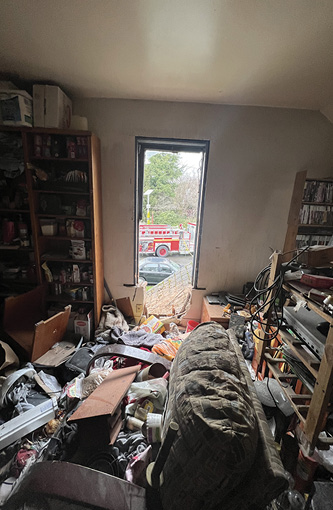
(8) A view of the same bedroom from the door, looking out to the window where the victim was removed.
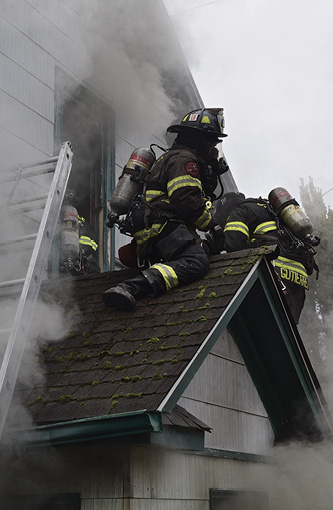
(9) L8 swapped search roles, with Team A moving outside to continue cutting the wall. Team B took over the search and was joined by L8’s officer. (Photos 9-13 by John Odegard.)
Ladder 8: Swapped Roles During VES
With his partner low on air, L8’s officer ordered a swapping of roles. He radioed, “Ladder 8 Team Alpha coming out, low on air,” and Team B was directed into the room to search while Team A completed the wall cut to expand the window. Once completed, L8’s officer reentered to assist with the search and continue clearing debris, as he still had sufficient air. Because of the significant challenges posed by the clutter, the search continued along the walls. Successful attack operations in the basement and closing the door stopped the deteriorating conditions in the room. L8 continued to update the IC on progress: “Search continuing floor 2, Alpha side. Smoke conditions improving. No heat. So far, no victim found.”
Fire Attack Continues
The ongoing efforts to extinguish the basement fire and stop extension from floor 1 continued with good success. A rapid intervention team was established and, after a thorough 360° survey, staged equipment on the A/D corner of the residence. Division Charlie was also established by an arriving chief officer. Ladder 5B reported hoarding conditions in the VES operation in the back room.
Making the Grab
L8’s officer and L8B continued to search and began moving toward the center of the room. As they moved back toward the window, L8’s officer, now reporting low air, located the victim underneath blankets in the center of the room. It would later be determined that the occupant had opened her closed bedroom door and was confronted with heavy smoke and heat. She moved back into the room and tried to close the door, getting it mostly shut. Overcome by the smoke/heat, all she could think to do was lie down in the middle of the room and cover up with blankets.
On finding the victim, L8’s officer radioed: “Victim found, floor 2, Alpha side. Coming out via ladder.” L8 dragged the victim to the bedroom window, which was now fully cut down, greatly aiding the effort.
L8 members on the small foyer roof repositioned the ladders from a standard climbing angle to a flatter position in line with the roof angle. The stability of this platform and the better slope were critical to victim removal. An additional roof ladder was positioned on the opposite slope of the roof to provide better footing/leverage for rescuers. The unconscious victim was transitioned from L8 to a member of L4, who began lowering the victim down the ladder. As the victim was moved to the ladder, her leg got pinned between the ladder and the siding of the house. Once her leg was freed, she was lowered down the ladder and transferred to Medic 18’s stretcher.
Medic 18 began lifesaving efforts, and the patient was transported to the hospital. Some 11 hours later, it was reported the patient was extubated and talking to family. The patient’s daughter called the firehouse to thank Seattle Fire and the victim spoke with the Battalion 4 chief (the initial IC).


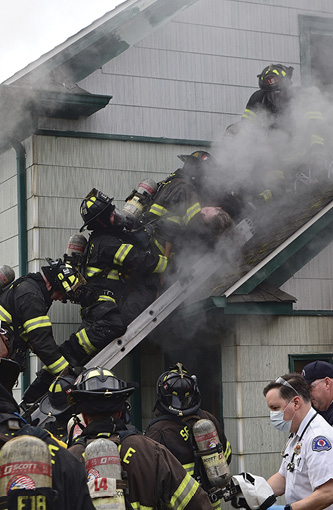

(10-13) The victim was rescued, taken down a ladder, and transferred to medics.
Lessons Learned
Adapting to changing fire attack: kitchen to basement. The initial indicators were a well-involved kitchen fire that was venting out the B-side door. The basement window was clear during the initial 360° survey, so fire attack began on floor 1. Critical to this fire was the recognition that a basement did exist, and that was radioed to the crews. Subsequent evaluation of the basement changed the fire attack, as fire and smoke were detected along with the conditions on floor 1 not improving.
Our information in the initial stages of the fire can be limited and, at times, conflicting. Add in the low-lying smoke that surrounded the home and rapidly changing conditions, and it is no surprise that a need to adjust occurred. As new information came to E18’s officer, he radioed the changes and altered the attack plan.
We must purposely train to be agile in our thinking and not get locked into a set approach to incidents that are anything but predictable. What may be the appropriate set of tactics at the onset of the fire can easily become the “wrong thing to do” as new conditions arise or updated information changes the scenario.
Coordinated attack: recognizing the search is opposite the handline and unprotected. With credible information that the victim was on floor 2 in a specific bedroom, L8’s officer wanted to find the interior stairs. Given the construction of the building and input from occupants, the stairs were best accessed through the A-side front door. Fire attack was occurring on the B-side door with slow progress.
The decision to find the stairs, opposite the fire attack, was made with full knowledge that conditions needed to be monitored closely. That fire attack crew was aware of L8A’s position in the structure, as was the IC. Further, L8’s officer was aware of their position, and the presence of hoarder conditions required caution because of the possibility of rapidly changing conditions. This played a role in his decision to exit the first time for additional information on stair location.
Many outstanding results at fires require a deviation from the normal script. One of the worst things happening to fire departments currently is the foolhardy attempt to rigidly script fire attack. Since fires don’t know the script or agree to follow it, we must be able to adapt and make decisions based on the variables in front of us. Those deviations are essential but also need to be communicated so everyone on scene understands the change from normal operations.
Although typically the search team would follow the handline or be provided protection by it, this fire didn’t present that way. The delay involved there, with a known rescue on floor 2, warranted a different tactic by the search team. This tactical change was communicated, and the elevated risks associated with the plan (opposite the attack line/not protected/hoarder conditions) were known and factored into the operation.
Information in the street: credible. There are a growing number of internet experts who declare some form of the following: “I don’t trust any information I get from bystanders or people outside the fire.” It’s a good thing that “wisdom” was not adhered to in this incident.
Both E18 and L8 benefited greatly from the information they received from occupants of the home and were able to determine if it was credible. Therein lies the value of such reports. Who is the person relaying the information, and how do you perceive the person’s mental status? Is the person authentically knowledgeable about the home and its occupants or just excited to be a part of it all? Does the information make sense based on what else you are seeing?
Entry/egress points, number of potential occupants, variables of the interior, and other such information can be invaluable. It was at this fire, as crucial details confirming the victim, likely location, and the best path to interior stairs were critical to the outcome.
Dual-pronged approach to search: interior and VES. We implement numerous search plans depending on the types of structures and fires we encounter. In this scenario, it was a small home with a known victim in a floor 2 bedroom. Although there has been significant interest in keeping crews together in recent years, this fire did not support that approach for the truck. L8’s officer wisely adapted to the conditions on the ground and the construction of the home.
Given the small footprint, he determined four members were not necessary to cover the interior search. Additionally, a dual-pronged attack, with the other two members attempting VES from the exterior at the known location of the bedroom, would provide two chances for success. As you have read, the interior option became untenable, and it was the VES tactic that proved the best option for this fire. The presence of hoarding conditions added to the wisdom of this approach, as there was no room to move, and searchers would have been on top of each other or pushing debris into each other’s path.
Adapting to changing information: interior halted because of basement fire/stairs. This was another great example of altering the plan based on updated information. L8’s officer was committed to finding the interior stairs and getting up to the floor 2 bedroom of the victim. After cutting a very difficult path to get to those stairs, you can imagine that urgency was elevated by finally locating them.
The presence of fire coming up through the stairwell treads was initially thought to be remedied by a pump can attack. Since this was thought to be a kitchen fire, the source of the fire was likely at that level. As that water was being applied, the radio transmission from E18 confirmed the presence of heavy fire in the basement.
The reality of heavy fire below and the likelihood of compromised stairs, with a fire that wasn’t being stopped by the pump can, forced a change in tactics. However hard it was to abandon those stairs, that was the correct call, given the updated information. Knowing he had a second operation happening outside, L8’s officer halted the interior approach and joined the exterior VES operation that would prove successful.
However difficult it may be to change directions in an ongoing tactic, we must face reality. The reality of compromised stairs in a hoarder-type house with heavy fire below that was not contained made a reconsideration necessary. The very real chance that L8A could have fallen through the stairs or been trapped above them made the VES operation the better choice. We must train our members to be comfortable in altering ongoing tactics and recognizing when what we’re doing, no matter how aggressively, is not working and we should move to a plan that will.
Close the door: flow path. One area identified as a potential problem was the crew not closing the A-side front door on entry. L8’s officer thought it had been done but found out afterward that it was still open. The possibility of allowing an open flow path to further intensify fire conditions and compromise the floor 2 rescue could have been limited by closing the door. There is ample evidence to support this truth, and I encourage you to drill on the many fine training resources available in Fire Engineering and the UL studies on this.
It is also important to highlight the realities that occur once the door is closed. Egress can now become more challenging, exterior lighting removed, and disorientation more likely. With every action we take, there tend to be good and bad elements associated with doing so.
In this scenario, the search crew was dealing with a fast-moving fire and a known rescue but also very difficult hoarding conditions. It is critical that all search training focuses on the need for the oriented member to remain vigilant for changing conditions and attuned to the egress point. Getting too involved in the search itself or, in this case, focusing on debris removal must not keep the oriented member from knowing how to get the team out. The closed door is necessary to keep fire from intensifying but needs to be coupled with training on the realities of a more difficult egress once closed.
VES: not all training should be done the same way. Getting our sets and reps down cold is crucial in all our tactical operations. This will require training with the buildings and props available to you, but it is absolutely necessary that we add elements to our drills that will be found in actual scenarios we are going to face when it’s real. This incident highlights that fact and is an opportunity to observe some actions that made a difficult operation less so.
The presence of hoarding conditions made the search and victim removal challenging. Some quick thinking by the search team mitigated some of the problems. Increasing the size of the window opening, removing a large amount of debris while the search occurred, and rotating crew members all aided in a successful outcome.
Consider adding elements to your VES training that don’t occur on standard concrete floors where victims slide easily. Alter the furniture layout and victim location to increase the mental modeling of what could happen. Most victims don’t get in the center of the room and cover themselves with blankets. This one did.
In addition, training for what actual victims feel like in a fire, with limited/zero visibility, is crucial. Reality has us needing to train with hose dummies and manikin-type props. We need to spend some time on what those “lumps” in the bedding may be or what’s in the gap between the mattress and the wall. Effort needs to go to quality thermal imaging camera training to identify key variables that distinguish likely victims from inanimate objects.
A fast time on the stopwatch of a drill tower VES is a fine thing. Finer still is changing variables, recreating scenarios from real fires and extended operations (from things like hoarder and changing fire conditions). These sets and reps, coupled with a rock-solid knowledge of the fundamentals, will enhance all operations.
Swapping roles: switching out crews/air management/assuming ongoing operations. A key part to the success of this incident was the swapping of roles within the tactical operations themselves. Just because you are assigned a particular task doesn’t mean you’ll be the one to complete it. Often, others will take up where we left off, and that is a critical component of solid fireground operations.
At multiple points, crews handed over unfinished tasks or gave way to another crew member better positioned to accomplish the task. The search on floor 2 could not be completed because of low air. Rather than just trying to complete the search and hoping an out-of-air emergency didn’t occur, L8A gave way to L8B, and the search ended with a successful grab. L8A did not just end the search and do nothing but completed the opening of the window that was crucial to aiding victim removal. L8’s officer even reentered, recognizing he had sufficient air, and was the one to find the occupant.
Even as the victim was being removed, the firefighter from L4 was in a much better position to receive the body and lower her down the ladder. The L4 member was also fresh and at full strength, making the difficult lowering angle and weight of the body an easier task than it would have been for already fatigued firefighters who found the victim.
Setting up removal for success: ladder positioning. When setting up to receive a victim, it is good to do some drills on different types of roof configurations. We often practice straight rescue from a ladder that is at a climbing angle. Adding in some different platforms, including the small foyer/dormer-type roof present at this rescue, is highly advised. At this incident, the A/D side of the foyer roof was blocked by a tree. Differing types of ground topography, landscaping, and other construction are just a few of the variables we encounter. Mix it up, and be creative in training on your setup.
Altering the angle of the rescue ladder to conform to the roofline made this rescue go much more smoothly. Although the low slope did make moving the body weight more challenging, it provided a stable platform and made for a quicker and safer removal. Additionally, the other side of the roof was stabilized by a roof ladder, which greatly impacted the ability of firefighters to move the body and provided leverage points that were essential.
Clear, concise radio updates. Clear, concise radio reports are the often-overlooked, and undeniable, glue that holds all our operations together. Incidents with clear communication stand out dramatically from those that are haphazard. From the opening description of the fire, which was challenging because of low-hanging/sight-obscuring smoke, to the ongoing updates on the search, communications were excellent during this fire.
Two key transmissions made a big difference in the outcome. The first was the notification that this was not just in the kitchen but also a well-involved basement fire. That observation and report changed the tactical trajectory of the entire firefight/rescue and contributed significantly to the positive outcome. The second was a communication from the IC altering the vent plan. An initial plan of vertical ventilation was changed based on the new update of a confirmed basement fire. The crew resources were instead directed to resume the interior search and a second VES operation that could have easily been where the victim was found had she moved from her initial location. Vertical ventilation was not indicated with the existing conditions, and the IC communicated the change brilliantly.
It may be boring to drill on the art of clear, concise radio transmissions, but every company should be practicing these skills, even those firefighters who “hate talking on the radio.” You never know who is going to be the one who needs to relay critical information, and everyone should be competent at doing so.
Mike Gagliano has more than 33 years of fire/crash/rescue experience with the Seattle (WA) Fire Department and the United States Air Force. He retired as the captain of Ladder 5 and is an (honorary) member of Fire Station 31. He has written numerous fire service articles and is co-author of the bestselling books Air Management for the Fire Service, Challenges of the Firefighter Marriage, and the SCBA chapter of Fire Engineering’s Handbook for Firefighter I and II. He is a member of the Fire Engineering/FDIC International Advisory Board, a Firefighter Air Coalition board member, and an advisory board member of UL’s Fire Safety Research Institute. He co-hosts the FireEngineering.com radio Webcast “The Mikey G and Mikey D Show” and partners with his wife Anne (Firelife.com) to teach strategies for developing and maintaining a strong marriage/family.

